Zotac ZBOX MAGNUS EN970 Review - A Gaming mini-PC Done Right
by Ganesh T S on September 28, 2015 8:00 AM ESTHTPC Credentials
Despite being actively cooled, I was pleasantly surprised by the noise profile of the system. The fans have variable rotational speeds, and in general, for most media related activities, the fan noise is minimal. I would go as far to say that the noise is probably the lowest amongst all the gaming mini-PCs that we have evaluated.
Refresh Rate Accurancy
Starting with Haswell, Intel, AMD and NVIDIA have been on par with respect to display refresh rate accuracy. The most important refresh rate for videophiles is obviously 23.976 Hz (the 23 Hz setting). The Zotac ZBOX MAGNUS EN970 does not have the same out-of-the-box accuracy possessed by Intel and AMD. However, NVIDIA also allows for setting custom resolutions and refresh rates.
The gallery below presents some of the other refresh rates that we tested out. The first statistic in madVR's OSD indicates the display refresh rate.
Network Streaming Efficiency
Evaluation of OTT playback efficiency was done by playing back our standard YouTube test stream and five minutes from our standard Netflix test title. Using HTML5, the YouTube stream plays back a 720p encoding. Since YouTube now defaults to HTML5 for video playback, we have stopped evaluating Adobe Flash acceleration. Note that only NVIDIA exposes GPU and VPU loads separately. Both Intel and AMD bundle the decoder load along with the GPU load. The following two graphs show the power consumption at the wall for playback of the HTML5 stream in Mozilla Firefox (v 41.0).

GPU load and VPU load were around 16.01% and 21.42% for the YouTube HTML5 stream.GPU load in the steady state for the Netflix streaming case was 5.88% and the VPU load was 4.36%.
Netflix streaming evaluation was done using the Windows 8.1 Netflix app. Manual stream selection is available (Ctrl-Alt-Shift-S) and debug information / statistics can also be viewed (Ctrl-Alt-Shift-D). Statistics collected for the YouTube streaming experiment were also collected here.

Decoding and Rendering Benchmarks
In order to evaluate local file playback, we concentrate on EVR-CP and madVR. We already know that EVR works quite well even with the Intel IGP for our test streams.
In our earlier reviews, we focused on presenting the GPU loading and power consumption at the wall in a table (with problematic streams in bold). Starting with the Broadwell NUC review, we decided to represent the GPU load and power consumption in a graph with dual Y-axes. Nine different test streams of 90 seconds each were played back with a gap of 30 seconds between each of them. The characteristics of each stream are annotated at the bottom of the graph. Note that the GPU usage is graphed in red and needs to be considered against the left axis, while the at-wall power consumption is graphed in green and needs to be considered against the right axis.
Frame drops are evident whenever the GPU load consistently stays above the 85 - 90% mark. An important aspect to note here for NVIDIA GPUs is that the load reported doesn't take into account the GPU clock. For example, the 4Kp30 clip in the EVR-CP mode: Initially, the GPU and VPU operate at higher clocks, resulting in the reported load being 7 - 8% and the power consumption being around 34W. However, later on towards the end of the stream, the load jumps up to around 12%, but the power consumption is now only around 25 W. Essentially, the power consumption at the wall is the real metric of efficiency for decode and playback. As long as the GPU load stays below the 85 - 90% mark, frame drops don't occur.
EVR-CP and madVR Defaults don't present any challenges to the GTX 960
Since the GTX 960 is a powerful GPU, we evaluated madVR with both default and stress settings. The 'madVR stress settings' was configured with the upscaling algorithms set to Jinc 3-tap with anti-ringing activated and the downscaling algorithm set to Lanczos 3-tap, again with anti-ringing activated.
The ZBOX MAGNUS EN970 was able to handle the madVR stress configuration without any issues.
Moving on to codec support, the GTX 970M / GM204 is a known quantity with regards to the scope of supported hardware accelerated codecs.
There is no HEVC_VLD_Main10 support. This is a bit disappointing since the real desktop GTX 960 supports Main10 decoding in hardware. Other than that aspect, the ZBOX MAGNUS EN970 actually makes for a reasonably power-efficient madVR-capable HTPC.


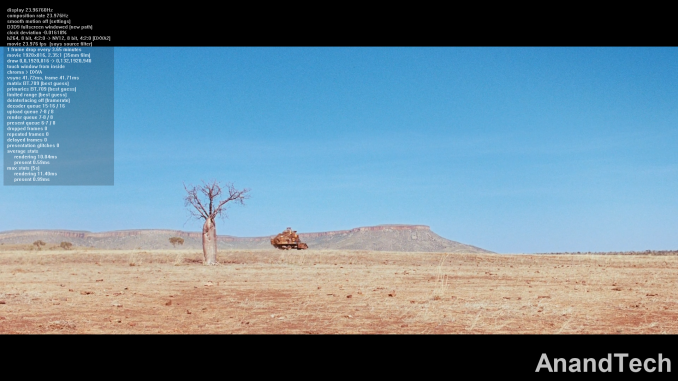



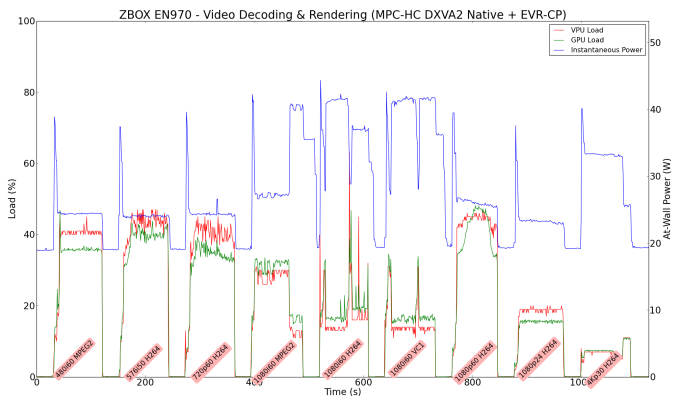
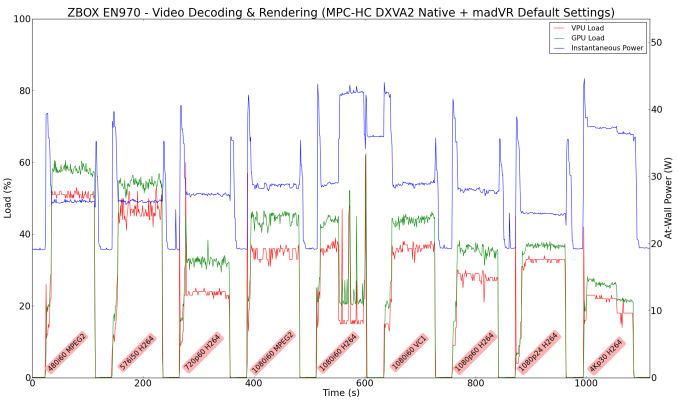
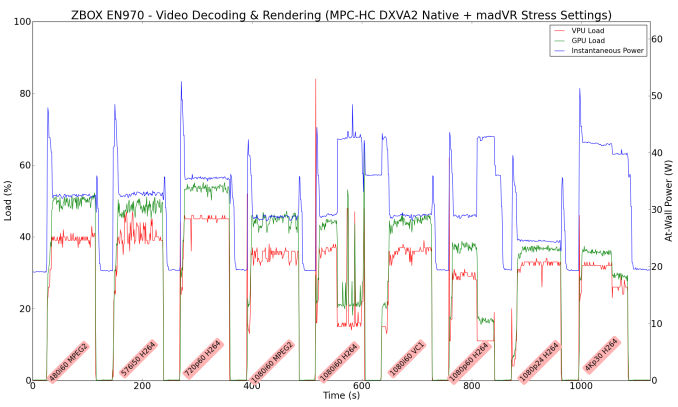
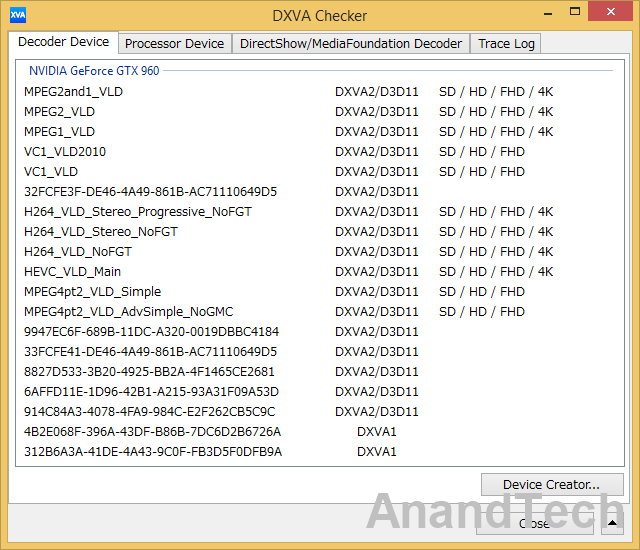








88 Comments
View All Comments
SpartyOn - Tuesday, September 29, 2015 - link
Apparently you either don't know what I'm talking about or have never used Steam In-Home Streaming. I'm not saying don't have a PC in the living room - in fact, I'm saying just the opposite - but make it an inexpensive media streaming box rather than a full-blown gaming system.I have two SFF media PC's, one in my living room and one in my basement, so I understand the need that these boxes fill. All I'm saying is that with Steam In-Home Streaming, that HTPC doesn't need to be a full-fledged gaming machine and your money can be better appropriated elsewhere.
donthatethesun - Tuesday, September 29, 2015 - link
I think this is more for people that don't necessarily want to have a desktop or multiple systems. It can function as their go to in the living room and for when they travel.lmcd - Tuesday, September 29, 2015 - link
Can't bring the desktop on a plane easily. There's your niche.tarak73 - Monday, September 28, 2015 - link
I am waiting for the same solution with DDR4 setup...rtho782 - Monday, September 28, 2015 - link
The 970m is a GM204 (desktop 970/980) with 1280 shaders instead of 1024 in the desktop 960 (gm206), 48 rops instead of 32, and, crucially, a 192bit memory bus instead of 128bit, so it should be a nice chunk faster than the desktop 960. The review seems to indicate that it being a 970m is a negative?KateH - Monday, September 28, 2015 - link
Yeah I was confused by that too. The only advantage I can see of the 960 vs 970m is that GM206 supports hardware decoding of some additional codecs that GM204 doesn't.rhx123 - Monday, September 28, 2015 - link
The lack of DisplayPort is a deal breaker. Very silly omission, with 4 HDMI Ports, it's not like space was at a premium.lmcd - Tuesday, September 29, 2015 - link
I likewise found this very disappointing. Particularly when none seem to be HDMI 2.0 (or am I wrong?).KateH - Tuesday, September 29, 2015 - link
All GM20x GPUs support HDMI 2.0 AFAIK, so I presume they are.meacupla - Tuesday, September 29, 2015 - link
Lack of DP is disappointing, but why is it a deal breaker?Did you want to use this with a G-sync monitor?